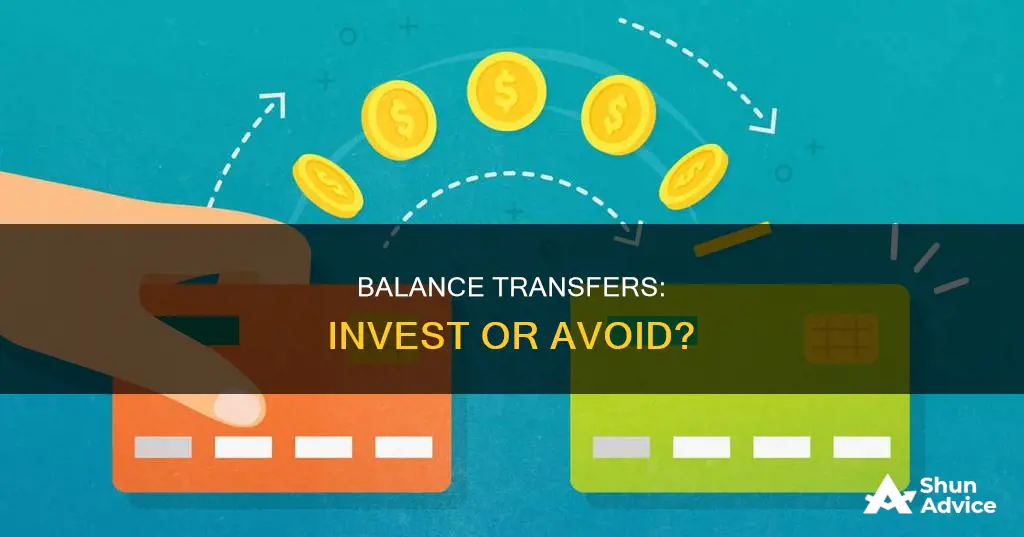
Balance transfers can be a great way to save money by moving debt from a high-interest credit card to one with a lower APR. However, there are some risks and drawbacks involved. On the one hand, a balance transfer can make it easier to pay off debt by giving you more time and saving you money on interest charges. On the other hand, there are fees, limits, and credit requirements associated with balance transfers that could potentially outweigh the benefits. So, should you use balance transfers to invest? It depends on your financial situation, risk tolerance, and investment goals.
| Characteristics | Values |
|---|---|
| Purpose | Save money by moving debt from a high-interest credit card to one with a lower APR |
| Who should do it? | Someone who is struggling to make progress on their credit card debt because interest eats up so much of their monthly payment |
| Who shouldn't do it? | Those who can pay off their credit card balance in three months or less |
| Pros | More time to pay off a balance; more manageable |
| Cons | Balance transfer fee; limits on how much you can transfer; good or excellent credit usually required |
What You'll Learn

Weighing the risks and benefits
Balance transfers can be a useful tool for wealth accumulation, but they also come with some inherent risks. Here are some of the key risks and benefits to consider before deciding whether to use balance transfers to invest:
Benefits:
- Low-interest debt: Balance transfers can be a form of "good debt" when used properly. They typically offer low-interest rates, sometimes even 0% APR for a promotional period, which can make them a very low-cost loan.
- Arbitrage opportunity: If you can find an investment with a higher interest rate than the cost of the balance transfer, you can profit from the difference in rates. This is known as credit card arbitrage.
- Wealth accumulation: By taking advantage of low-interest rates and arbitrage opportunities, balance transfers can be used to accumulate wealth over time.
- Debt consolidation: Balance transfers can help simplify your financial situation by consolidating multiple debts into a single payment with a lower interest rate.
Risks:
- Poor investments: One of the key risks of credit card arbitrage is the possibility of making poor investments. It can be challenging to find safe investments that offer a significantly higher rate of return than the cost of the balance transfer.
- Creating a debt habit: Engaging in credit card arbitrage can encourage unhealthy financial behaviours, such as carrying high levels of debt.
- Defaulting on the loan: If you fail to repay the balance transfer according to the terms, you will be charged late fees and a much higher interest rate, which can quickly saddle you with debt.
- Credit score setbacks: Opening a new line of credit and increasing your debt can negatively impact your credit score. This can affect your ability to obtain other loans, such as a mortgage.
- Rule changes: Credit card companies can change the terms of your loan at any time, such as increasing interest rates or adding fees, which can nullify any financial gains.
Overall, balance transfers can be a powerful tool for wealth accumulation, but they also come with significant risks. It is essential to carefully consider your financial situation, risk tolerance, and investment options before deciding whether to use balance transfers to invest.
Cashing Out Your Fidelity Investments: A Step-by-Step Guide
You may want to see also

Understanding balance transfer fees
Balance transfer fees are incurred when a cardholder transfers a balance from one credit card to another. The fee is usually a percentage of the total amount transferred and is imposed by the lender or the institution receiving the balance. The fee can vary from 2% to 5% of the transferred amount or be a fixed amount, whichever is greater. For instance, a 2% fee on a $300 balance transfer would result in a $6 fee.
These fees are typically charged by credit card companies when cardholders move balances from a high-interest card to a card with a lower interest rate or a 0% introductory offer. Balance transfers can help consolidate debt and save money on interest charges.
While some credit card companies may offer promotional periods with no balance transfer fees, these are usually introductory offers to attract new customers. It is important to carefully review the terms and conditions, including the annual fee, the teaser rate, and how long it lasts.
Additionally, there may be ways to avoid or reduce balance transfer fees. Some credit cards, particularly those issued by credit unions, may waive these fees entirely. Negotiating with the card provider or shopping around for cards with low balance transfer fees can also help minimize costs.
In conclusion, balance transfer fees are an important consideration when transferring credit card balances. While they can help save money on interest, it is crucial to understand the associated costs and weigh them against the potential benefits.
Invest with SRS and DBS: A Smart Guide
You may want to see also

Knowing your credit score
Understanding Your Credit Score
Your credit score is a critical indicator of your financial health and creditworthiness. It provides lenders and creditors with an overview of your credit history, including your ability to manage debt and make timely payments. A strong credit score can make it easier to obtain loans, credit cards, and favourable interest rates.
Factors Affecting Your Credit Score
Several factors contribute to your credit score calculation:
- Payment History: A strong history of on-time payments is essential for a good credit score. Late or missed payments can significantly damage your score.
- Credit Utilization: This factor considers the amount of credit you're using relative to your total credit limit. It's recommended to keep your credit utilization below 30%, with lower utilization indicating responsible credit management.
- Length of Credit History: Lenders favour longer credit histories as it demonstrates experience in handling credit. Opening new accounts or closing old ones can impact the average age of your accounts, potentially lowering your score.
- Credit Mix: Lenders like to see a diverse range of credit types, such as credit cards, mortgages, or loans. This factor assesses your ability to manage different types of credit responsibly.
- New Credit: Applying for new credit can trigger a hard inquiry, which can slightly lower your score. Multiple hard inquiries in a short period can have a more significant negative impact.
Checking Your Credit Score
You can obtain your credit score from various sources, including your bank, credit card issuers, or reputable websites. Keep in mind that you may have multiple credit scores, as they are calculated using different models and factors.
Impact of Balance Transfers on Your Credit Score
Balance transfers can influence your credit score in both positive and negative ways:
- Positive Impact: Transferring balances to a new card with a higher credit limit can lower your overall credit utilization, which is beneficial for your score. Additionally, making timely payments on the transferred balance can improve your payment history.
- Negative Impact: Applying for a new balance transfer card can result in a hard inquiry and reduce the average age of your accounts, potentially lowering your score. Closing old accounts after transferring balances can also negatively impact your score.
Strategies for Maintaining a Good Credit Score
To maintain and improve your credit score:
- Limit Credit Applications: Avoid applying for multiple new credit cards or loans simultaneously, as this can result in multiple hard inquiries and negatively impact your score.
- Maintain Low Credit Utilization: Keep your credit utilization below 30% by ensuring your debt remains well below your total credit limit.
- Make Timely Payments: Pay your credit card bills and loan payments on time, every time. Late or missed payments can significantly damage your score.
- Monitor Your Credit Report: Regularly review your credit report for accuracy and dispute any errors. You're entitled to a free credit report from each of the major credit bureaus annually.
- Practice Responsible Credit Behaviour: Avoid excessive debt accumulation, and only take on new credit when necessary. Demonstrating responsible credit management over time will reflect positively on your score.
Cash Reserves Investments: A Safe Haven for Your Money
You may want to see also

Exploring alternative options
Balance transfers can be a great way to save money by moving debt from a high-interest credit card to one with a lower APR or 0% introductory APR. However, there are some drawbacks and alternative options to consider. Here are some alternative options to explore:
- Personal loans: If you have multiple large balances that you want to consolidate, a personal loan might be a better option. With a personal loan, you can borrow a lump sum of money and use it to pay off your credit card debt. Personal loans typically have lower interest rates than credit cards, and you can usually get a fixed interest rate and fixed monthly payments. However, you will need good to excellent credit to qualify for the best personal loan rates.
- Debt consolidation loans: If you are struggling to make progress on your credit card debt because of high-interest rates, a debt consolidation loan can help. This type of loan allows you to combine multiple debts into one new loan with a lower interest rate and more favourable terms. This can make it easier to manage your debt and reduce the amount of interest you pay over time.
- Using a line of credit: Depending on your financial situation, using a line of credit, such as a home equity line of credit (HELOC) or an unsecured line of credit (uLoC), can be an alternative to a balance transfer. These options typically offer relatively low-interest rates, and the interest may even be tax-deductible in some cases. However, it's important to carefully consider the risks and ensure you have a plan to pay off the debt.
- Arbitrage opportunities: Credit card arbitrage involves borrowing money from credit card companies at a low or 0% interest rate and investing it in instruments offering a higher interest rate. While this can be a profitable strategy, it carries significant risks, including poor investments, creating a debt habit, defaulting on the loan, and negative impacts on your credit score. It's also important to note that credit card companies have been pulling back from 0% offers, making it harder to find profitable arbitrage opportunities.
- Paying off debt quickly: If you can pay off your credit card debt within three months or less, it might be better to avoid a balance transfer and simply focus on paying off the debt as quickly as possible. This option may require you to tighten your budget or find ways to increase your income, but it can help you save on interest charges and avoid the potential drawbacks of balance transfers.
Fidelity's Cash Policy: What Investors Need to Know
You may want to see also

Creating a repayment plan
Understand the Costs Involved:
Before initiating a balance transfer, make sure you fully comprehend the associated fees and charges. Typically, balance transfers come with a balance transfer fee, which is a percentage of the total amount transferred. This fee is usually between 1% and 3% of the transferred sum. Additionally, some banks may charge an initialization or set-up fee for the promotional rate. Make sure to read the terms and conditions carefully to identify all applicable fees.
Set a Realistic Repayment Timeline:
When creating your repayment plan, it's important to be realistic about how long it will take to pay off the transferred balance. Consider the amount you can afford to pay each month and calculate how many months it will take to fully repay the debt. Keep in mind that longer repayment periods may result in higher overall interest charges.
Make a Budget and Stick to It:
Examine your income and expenses to create a budget that includes the monthly payments for your balance transfer. Ensure that you can commit to making the minimum payments on time, every time. Automating your payments can help ensure that you never miss a due date.
Prioritize Repayment:
During the promotional period with a low or 0% interest rate, focus on repaying the transferred balance as quickly as possible. Avoid using the credit card for new purchases, as this will only increase your debt. If you have multiple debts, prioritize the one with the highest interest rate or the one closest to its promotional period ending.
Consider Using a Line of Credit:
If you're unable to pay off the entire balance by the end of the promotional period, consider using a line of credit, such as a home equity line of credit (HELOC) or an unsecured line of credit (uLoC), to pay off the remaining balance. This strategy, known as "balance transfer churning," can help you maintain a low-interest rate and give you more time to repay the debt.
Have a Backup Plan:
It's always a good idea to have a backup plan in case of unexpected expenses or financial setbacks. This could include having access to emergency funds or a separate line of credit that you can use to make payments if needed. Remember that defaulting on your payments can have serious consequences, including late fees and a negative impact on your credit score.
Stay Disciplined:
Using balance transfers to invest requires discipline and financial responsibility. Avoid the temptation to spend the transferred funds on non-essential purchases. Stay focused on your investment strategy and stick to your repayment plan.
Cash App Investing: A Guide to Getting Started
You may want to see also







